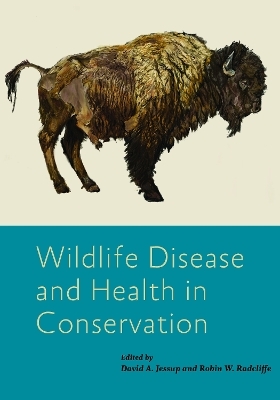
Wildlife Disease and Health in Conservation
Johns Hopkins University Press (Verlag)
978-1-4214-4674-5 (ISBN)
Wildlife diseases and their implications are at the forefront of many sectors of scientific endeavor, especially in the wake of the COVID-19 pandemic. Nearly 60 percent of all human diseases and 75 percent of all emerging infectious diseases are zoonotic. Edited by pioneering wildlife veterinarians David A. Jessup and Robin W. Radcliffe, Wildlife Disease and Health in Conservation explores the origins and impacts of as well as the responses to the most damaging and persistent diseases currently threatening wildlife conservation.
Focusing mainly on newer, invasive, and controversial wildlife health challenges, this book also reexamines classic diseases that provide warnings and important lessons for wildlife professionals and policy makers. Each chapter offers cutting-edge scientific information and extensive references to help readers plan for, respond to, and conduct research on these serious health challenges. This book:
• Reports crucial findings on newly emerging diseases and how to recognize and manage them
• Explores the health of critical but often neglected aquatic ecosystems, including both vertebrate and invertebrate examples
• Covers a vast diversity of wildlife health threats, from epizootic bighorn sheep pneumonia and African swine fever to sea star wasting disease, avian influenza, and rabbit hemorrhagic disease
• Explains zoonotic dangers to humans, including coronaviruses
• Includes information on marine and aquatic species, wild ungulate species, carnivores and omnivores, birds, and more
• Provides insight into the social, legal, financial, and political factors that may override or influence conservation priorities in response to biomedical challenges
Featuring detailed and attractive field notes–style illustrations by Laura Donohue and essential essays from experts in the field, Wildlife Disease and Health in Conservation combines theory and practice to inform and inspire wildlife health and conservation.
David A. Jessup (ROYAL OAKS, CA) is the former senior wildlife veterinarian of the California Department of Fish and Game and the former executive manager of the Wildlife Disease Association. Robin W. Radcliffe (BROOKTONDALE, NY) is a wildlife veterinarian. He is the author of the children's book The Hornless Rhinoceros and founder of a learning program with Dr. Jane Goodall that trains the next generation of conservation leaders at Cornell University.
Sponsors and Supporting Organizations
Introduction: David A. Jessup, by David A. Jessup
Part I: Wildlife Disease/Health in Marine and Aquatic Species
1. Coral Reef Ecosystem Health, by Thierry M. Work
2. Sea Star Wasting Disease, by Joseph K. Gaydos
3. Wild Fisheries: One Health Challenges Affecting Us All, by ESP Weber III and O. Rozanski
4. Ranavirosis and Chytridiomycosis: Impacts of Amphibian Species, by Debra L. Miller, E. Davis Carter, Rebecca Hardman, and Matthew J. Gray
5. Oil Spills and Their Management, by Michael Ziccardi
6. Prescriptions for Reducing Ocean Pollution and Saving Southern Sea Otters, by David A. Jessup and Melissa A. Miller
Part II: Wildlife Disease/Health in Wild Ungulates
7. Great Plagues: Rinderpest, Peste des Petits Ruminants, Measles and Distemper, by Richard A. Kock
8. Chronic Wasting Disease, by Michael W. Miller and Lisa L. Wolfe
9. Epizootic Bighorn Sheep Pneumonias, by Thomas E. Besser and E. Frances Cassirer
10. Bovine Brucellosis in the Greater Yellowstone Ecosystem, by Bant Schumacker
11. Bluetongue, EHD and Cervid Adenoviral Hemorrhagic Disease, by Mark L. Ruder and Sonja J. Christensen
12. African Swine Fever, by Vienna Brown, Julianna Lenoch, and Courtney Bowden
Part III: Wildlife Disease/Health in Carnivores, Rodents, and/or Bats
13. Plague and Distemper in Prairie Dogs and Black Footed Ferrets, by Toni E. Rocke
14. Rabies and Conservation, by Thomas Muller and Charles E. Rupprecht
15. Rabbit Hemorrhagic Disease, by J. Jeffrey Root and Tom Gidlewski
16. White-nose Syndrome, by Michelle L. Verant and Riley Bernard
Part IV: Wildlife Disease/Health in Avian Species
17. Waterfowl Diseases: Catalyst for Wildlife Health in North America, by David A. Jessup
18. Avian Influenza in Wild Birds, by Andrew M. Ramey
19. Avian Malaria and the Extinction of Hawaiian Forest Birds, by Carter T. Atkinson
20. Lead Intoxication in Raptors and Scavenging Birds, by Michelle Hawkins, Krystal M.T. Woo, and Katherine Carr
21. Gyrfalcons as Sentinels for Changing Disease Ecology in the Arctic, by Robin W. Radcliffe and Michael T. Henderson
Part V: Wildlife Diseases Crossing Species and Geographic Barriers
22. Tuberculosis in Free-ranging Wild Animals, by Michele A. Miller
23. Toxoplasmosis and One Health, by Elizabeth Van Wormer and Karen Shapiro
24. Endangered Mountain Gorillas, Ebola and Community Health, by Kirsten Gilardi
25. Emerging Coronaviruses: A One Health Harbinger, by Christine K. Johnson, Janna Freeman, Tierra Smiley Evans, Diego Montecito, and Marcela Uhart
Conclusion
| Erscheinungsdatum | 03.08.2023 |
|---|---|
| Reihe/Serie | Wildlife Management and Conservation |
| Zusatzinfo | 3 Illustrations, black and white; 3 Illustrations, black and white; 109 Illustrations, color; 71 Illustrations, color |
| Verlagsort | Baltimore, MD |
| Sprache | englisch |
| Maße | 178 x 254 mm |
| Gewicht | 1520 g |
| Themenwelt | Naturwissenschaften ► Biologie ► Ökologie / Naturschutz |
| Veterinärmedizin ► Klinische Fächer | |
| ISBN-10 | 1-4214-4674-X / 142144674X |
| ISBN-13 | 978-1-4214-4674-5 / 9781421446745 |
| Zustand | Neuware |
| Haben Sie eine Frage zum Produkt? |
aus dem Bereich


